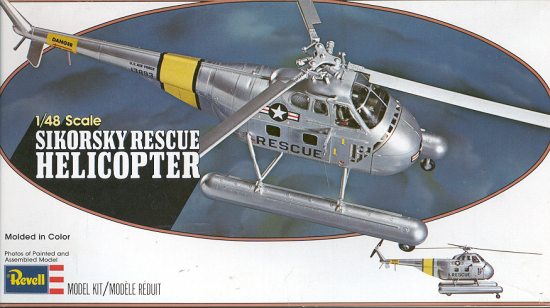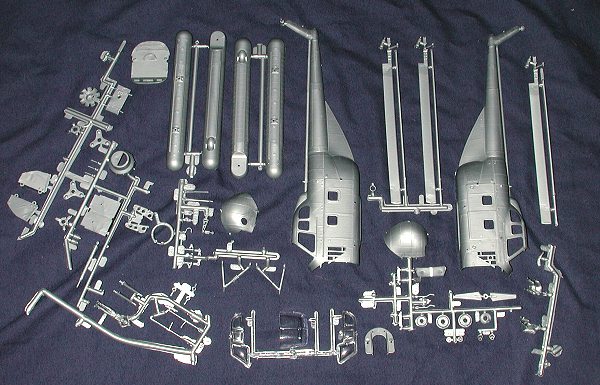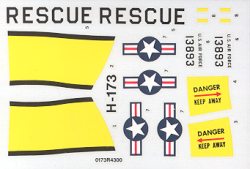
|
KIT: |
Revell 1/48 H-19 |
|
KIT # |
H-173 |
|
PRICE: |
$? |
|
DECALS: |
one aircraft |
|
REVIEWER: |
|
|
NOTES: |
1979 boxing |

|
HISTORY |
The UH-19B is a USAF version of the Sikorsky S-55, an aircraft used by all U.S. military services in the 1950s and 1960s. It was the first of the Sikorsky helicopters with enough cabin space and lifting ability to allow satisfactory operation in troop transport or rescue roles. The engine is mounted in the nose, leaving the main cabin free for passengers or cargo. The prototype was first flown in November 1949, and in 1951 the USAF ordered production model H-19s (redesignated UH-19s in 1962). After receiving 50 H-19As, the USAF acquired 270 H-19Bs with increased engine power. Many were assigned to Air Rescue squadrons as SH-19s (later redesignated HH-19s). For rescue service, a 400 lb. capacity hoist was mounted above the door. The aircraft also could be equipped with an external sling capable of carrying 2,000 lbs. During the Korean War, H-19s were used extensively for rescue and medical evacuation work. Other missions included observation and liaison. The H-19 flew the first helicopter combat airlift missions during the Korean War while serving with the U.S. Marine Corps as the HRS.
An H-19A known as "Hopalong," was one of two H-19s to make the first trans-Atlantic helicopter flight, traveling during the summer of 1952 from Westover AFB, Mass. to Scotland in five stages. Thanks to the USAF Museum for the above historical background.
|
THE KIT |

You know, looking at the sprues of this old kit (and old it is, being basically a 60's model), it is amazing how far we have come. For instance, today's kits have nice, square or at least geometric sprues. This one has sprues where they are needed and often they are cut off. This was so that they'd fit into the 'standard' box of the time, which was much longer than it was wide. Shelf presence wasn't a buzz word back then so you don't see small kits in way too large boxes as often is the case today.
The kit also has quite a few rivets. Again, that was the norm and often what made it 'authentic'. This particular kit has the ability to be built either on floats or wheels, It also has a forward engine compartment that can be opened to show the detailed engine within. Of course, all this makes it a real challenge to find a spot for the nose weight, as without it, this one is a real tail sitter. The kit also includes a fairly well detailed cockpit section, complete with crew members. Typically, there is no collective so you'll have to make that out of stretched sprue. It also includes a ground crewman and a fellow being hauled up on the hoist. I doubt if you'd use these two items at the same time!
One of the real faults of these older kits is that the engineers who designed
the kits didn't care about ejector pins so many of
 the parts have these pesky things
in the most unwanted places. Combine that with the flash that is inevitable as a
mold gets older and you have quite a clean-up chore ahead of you. However, the
fact remains that if you want an H-19 in 1/48, then this is your only real
option.
the parts have these pesky things
in the most unwanted places. Combine that with the flash that is inevitable as a
mold gets older and you have quite a clean-up chore ahead of you. However, the
fact remains that if you want an H-19 in 1/48, then this is your only real
option.
The instructions are totally pictorial and broken down into 45 construction steps. No color information of any kind is given, not even in the decal section, so you are up to your own research for that info. Decals are generic to the max and very glossy. They are also of the type that is quite suspect as to their effectiveness. Were I the builder, I'd paint on as many of the markings as possible and head for the spares box for the others.
|
CONCLUSIONS |
Until a new 1/48 H-19 comes around, this is your only choice. Having said that, I can tell you that I've seen this kit made into a real beauty, though I'm sure it took some work and careful construction.
|
REFERENCES |
http://www.wpafb.af.mil/museum/
If you would like your product reviewed fairly and quickly by a site that has well over 150,000 visitors a month, please contact me or see other details in the Note to Contributors.